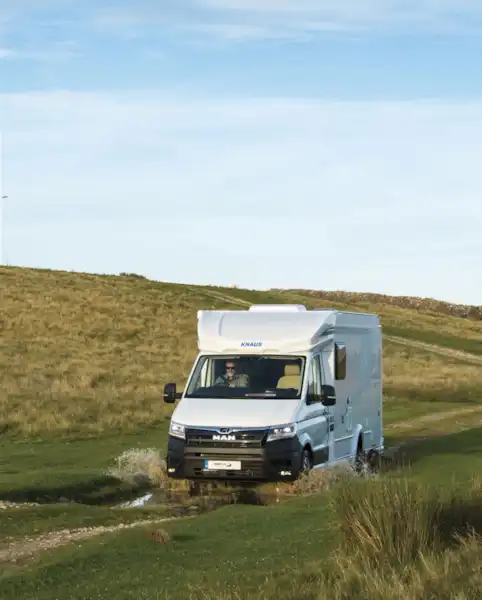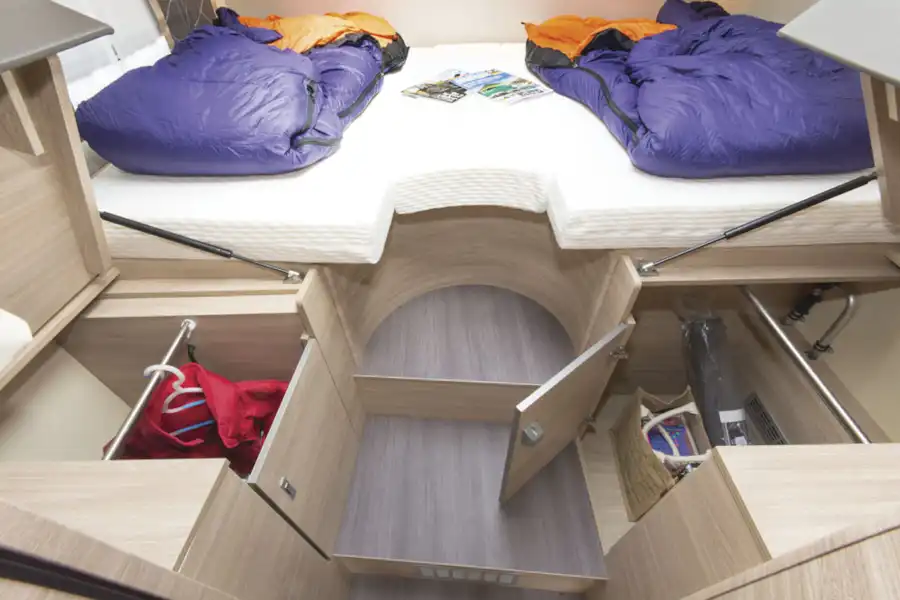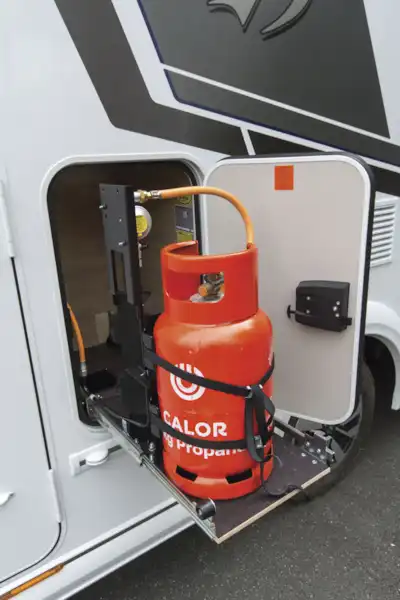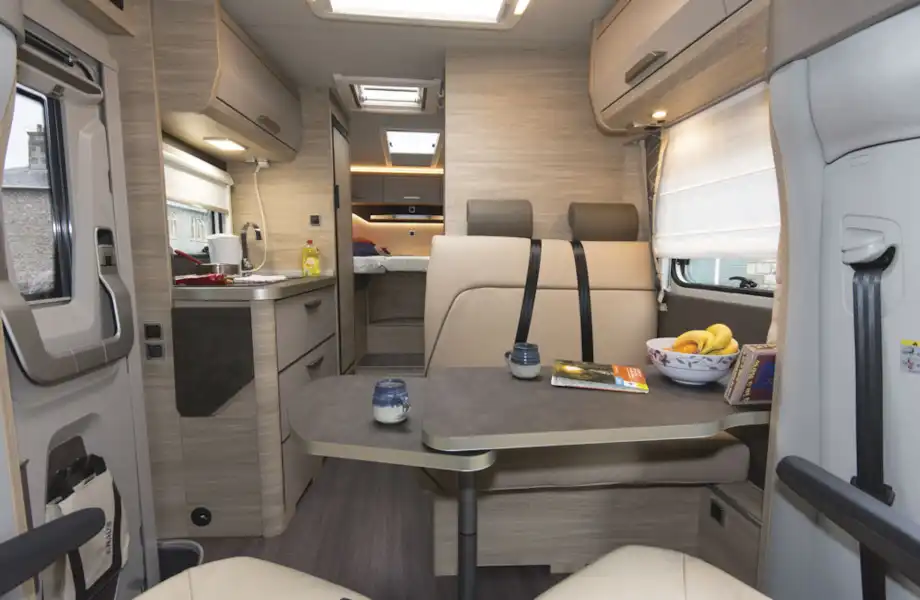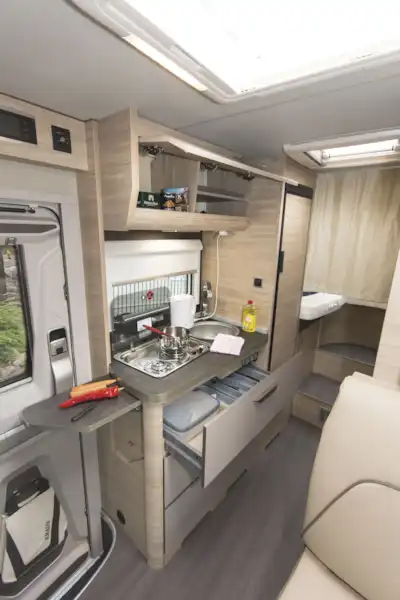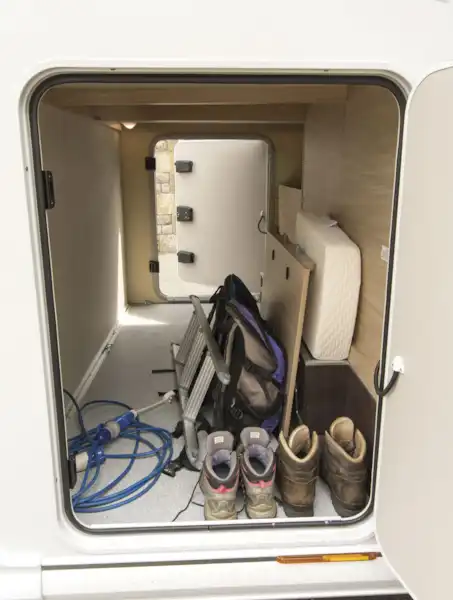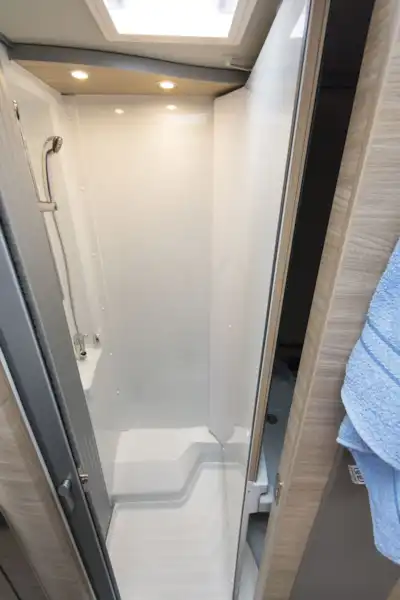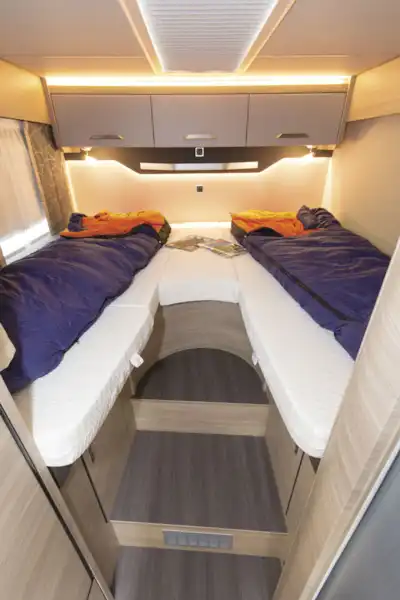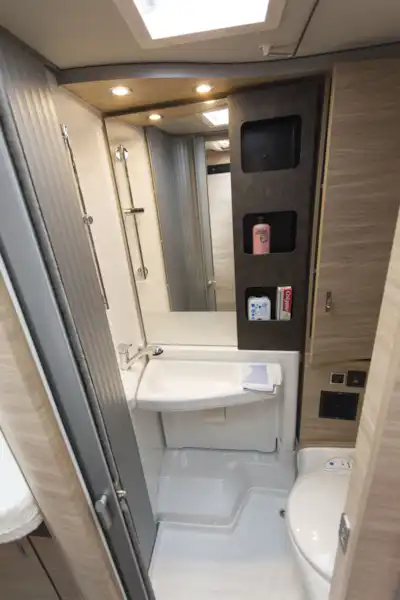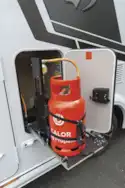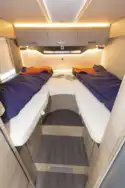Key Features
| Model Year | 2021 |
| Class | Low Profile |
| Base Vehicle | MAN |
| Price From (£) | 79,809 |
| Engine Size | 2.0TD |
| Maximum Weight (kg) | 3,500 |
| Berths | 2 |
| Main Layout | Fixed Single Bed |
At a glance
Full review
Words and photos: Andrew and Rona Bromley
Here's a first – a road test of a motorhome on the MAN TGE chassis-cab. It’s really a VW Crafter with different badges (MAN, the lorry manufacturer, is part of the Volkswagen Group), but that’s no bad thing as the Crafter is one of the best base vehicles around.
Few converters are currently using the MAN, although Westfalia switched its Sven Hedin high-top camper from the VW to its sister in 2019. Knaus, meanwhile, offers a two-model range of Van TI Plus on the MAN TGE. Its other ranges remain Fiat Ducato-based but, given the uniformly high plaudits the new Crafter has received, the more expensive base should add considerable appeal.
Read more motorhome and campervan reviews every month in MMM, What Motorhome and Campervan magazine
Moreover, this Van TI Plus has a very tempting specification. It isn’t cheap, at around £85,000 fully spec’d, but that’s pretty typical for a high-quality German motorhome – and this one has the optional Haldex four-wheel drive, a 175bhp engine and an eight-speed automatic gearbox.
That alone accounts for over £7k above the standard front-wheel drive, 138bhp, manual version. The MAN Package, Van TI Plus Package, Light & Visibility Package and Media & Assistance Package, all of which cost extra on the Continent, are standard in the UK.
The Van TI Plus 650 MEG measures just under 7m long (there’s also a longer model with a French bed) but, at only 2.20m wide, it’s significantly slimmer than the standard 2.35m coachbuilt. That extra 6in of road space is very reassuring when faced with a fast-moving oncoming lorry.
Knaus produces top-quality, durable products, so the Van TI Plus has a 10-year leakproof warranty, heavy-duty aluminium sandwich sidewalls, a GRP-covered underfloor, and the roof is high-glass-content fibreglass for strength and hail-protection. In basic trim, both models have 3,500kg gross weight, so are driveable on a standard licence, and the nominal payload is pretty good at 474kg.
However, the test vehicle’s optional extras reduce this to only 213kg. Fortunately, chassis upgrades to 3,850kg or 4,000kg are available for those with the relevant licence.
Externally, the Van TI Plus gives no indication of its 4x4 capability, with no greater ground clearance (unlike the Sprinter 4x4 used by Hymer) and the 17in alloy wheels have ordinary road tyres. Moreover, with a significant (2.34m) rear overhang, this is clearly no Land Rover!
The Knaus does look smart, though, and the chunky MAN nose with lion insignia is distinctive.
You enter the cab to an aroma of leather but, that aside, the seats are also exceptionally supportive and multi-adjustable.
The fascia, typically VW, is classically simple, in robust, high-quality materials. Dashboard dials are clear and informative and the leather-clad multifunction steering wheel is easy to use regarding infotainment and the myriad safety controls.
The central fly-off handbrake causes no obstruction when swivelling the seats and there are cup holders and storage aplenty, plus an 8.5in touchscreen for navigation, music, etc. The gearstick can be worked manually (no paddles, unfortunately) and offers normal Drive and Sport modes. With eight gears, you’d quickly lose count, but the display indicates the current gear (always far higher than expected).
Driving was simplicity itself, with excellent visibility and a reversing camera viewed through the touchscreen. The powerful engine has a splendid turn of speed – once it gets going. It’s slow taking off at roundabouts and junctions, because its rapid upward gearchanges mean you’re in third by 15mph – even selecting Sport made little difference.
We found the ride too soft, until we realised the rear air-suspension units (standard fitments) were inflated. Press the two dashboard buttons, release the air, and the ride was much improved.
Generally, steering was light and responsive but, if you changed lane without indicating, it hardened, feeling like an importunate child tugging your arm: that’s the Lane Assist function.
It can be switched off by scrolling through the controls, but the default is ‘on’, so this must be repeated before every journey. That aside, we found the MAN easy and pleasant to drive, and the Knaus interior was exemplary in its quietness with absolutely no rattles.
Given the fitted 4x4 system, we felt honour-bound to try some off-roading. The MAN/VW system uses front-wheel drive on dry roads, changing instantly and imperceptibly to AWD as sensors dictate.
Being conscious of the road tyres and the low-slung overhang, we were pretty cautious, and found the air suspension very reassuring as, once deployed, it raises the rear end several inches (particularly useful on ferries). The four-wheel drive could be very useful on grass pitches or during the winter.
Moving inside via the retracting step, the habitation door has a window, full flyscreen, nifty umbrella store and hook for a smart Knaus bag, though a bin might have been more useful.
Interior décor is, as expected, beige and grey, with woodwork in pale Egmond Elm and upholstery in that Las Vegas two-tone leather.
It’s all very well executed but, despite a Midi Heki, the lounge’s ambience would be greatly enhanced by the optional overcab skylight.
Lighting is slightly lacking with just a couple of strips in the Heki surround, some high-level ambient strips and a pair of downlighters under the nearside overhead locker – there are no reading lights for the cab seats.
The wall-mounted table is quite small, but a swivel-out section brings it within reach of all. As the cab floor is slightly lower than the van body, the table is a trifle high for cab seat occupants.
There’s a lower wall fixing for the table so that it can be used for the base of a child’s bed. More practically, the table extension is accessible from the kitchen, thereby increasing the minimal work surface. The half-dinette bench is quite upright, but Knaus claims it’s optimised to maintain a ‘healthy posture’ while travelling.
The test motorhome had no television points, but any TV would be mounted behind the travel seats and be viewable from the cab seats. However, there are mains sockets both above and below the table, plus another (with USB) below the overhead locker, and there’s an extra audio speaker.
In the kitchen there’s a two-burner hob, a small circular sink with flashy, too-high mixer tap and a mains socket that’s poorly placed, so the kettle is squashed between the hob and sink. The high-level cupboard is shelved and divided and, in the unit below are two very large soft-close drawers (one with cutlery tray).
There’s no oven or grill, but one is optional (at £619) and it’s installed in the galley, rather than above the fridge. Work surface is limited, other than a lift-up flap at the end of the unit. The 142-litre AES fridge/freezer is the star feature of a compact galley in a relatively compact (6.99m) motorhome.
There is, however, a gas barbecue point by the habitation door and plenty of room for the barbie in the garage, so perhaps you’ll eat al fresco, shaded from the summer sunshine by the full-length awning.
Opposite the kitchen, the washroom is altogether more ambitious. Of necessity, it’s quite small but adequately proportioned. A rather flimsy tambour door reveals a Thetford bench toilet to the right, with mirror above.
Opposite the door, the deep moulded basin has a toilet roll holder below and another mirror above, illuminated by two ceiling lights. Alongside is a stack of three wall cubbies and a shelved cupboard is beside the toilet.
The shower tray with two drain holes forms the floor, the basin tap doubles as a showerhead when clipped to a riser bar and the wall holding the basin swings towards the loo, forming a good-sized, plastic-lined shower cubicle.
The swing-wall doesn’t quite swing back fully, being obstructed by the toilet, so the shower entrance is quite narrow. However, the tambour door slides around and connects magnetically to the swing-wall, making everything waterproof. The skylight has a drop-down towel rail/wet clothes hanger, and there are a couple of hooks.
And so to bed, reached by the steps – two of them lead to twin singles, each measuring an excellent 2.01m by 0.80m, and with a central cushion joining them down to waist level. A further central bed-base extension, plus extra cushion and short ladder, creates a massive double. The mattresses are EvoPore HRC, over slatted bases, and a WaterGel mattress topper is optionally available if you find them too firm.
The bedroom has only one window, on the offside, presumably so you could sleep transversely. However, we’d specify the optional second window and sleep longitudinally, as the under-slatting is designed that way and there would be fewer joints in the mattresses.
With the motorhome’s long overhang, it’s beneficial that steadies are fitted and the air-suspension can be used individually for levelling up. The bedroom had the optional panoramic skylight, giving an airy feel and there are two reading lights in the base of the overhead cupboards, though there’s insufficient room beneath to sit up.
There’s also an ambient lighting strip above the cupboards and a blue ‘locating’ dot by the steps, but no other lighting, just one mains socket, and no USB point.
Bedroom storage includes three overhead lockers, two high-level cubbies above the foot of the beds, and wardrobes under each bed foot. Access is either from the front or the top by lifting the lower section of bed. However, they’re quite shallow, and most clothes will trail on the floor.
The lounge has a nearside shelved overhead locker, plus a shelf around the overcab, and two small cubbies either side. That’s about it, though, as the travel seat base is filled by the fresh water tank and Alde heater.
The main storage area is the large, bike-swallowing garage, which can carry 250kg (subject to payload and rear axle limits) and is equipped with tying points, plus two lights. One door is standard, but this example had two, both 0.74m by 1.05m. The garage also holds the two 80Ah leisure batteries, and all the electrical ‘magic boxes’ are within easy reach of the nearside door.
The Knaus, as tested, is very well equipped, though many goodies are options, such as the Alde heating. There’s also Truma electric heating in the kitchen unit, giving instant heat whilst the Alde system is limbering up.
There’s central locking and the external gas locker takes two 11kg cylinders on a slide-out tray (clever, but optional). A water filtration system, though, is standard.
We liked the nearside service hatch where you can fill the 100-litre fresh water tank by hose and empty both fresh and waste tanks remotely; far better than scrabbling underneath for dirty taps. And, of course, there’s that vast array of sophisticated driving aids from MAN.
Expert motorhome advice to your door!
Why not subscribe to one of our fabulous magazines and get expert advice, travel ideas, technical help and all the latest news for your motorhome and your motorhome adventures!
Want to know more about MMM magazine?
Every month MMM has articles written by motorhomers who have been there and done it, from great UK and European (and further afield) tours, campsite reviews, owners' reports and DIY projects among other things. MMM's tests, reviews and expert buying guides are not to be missed. MMM's technical advice is a must and includes everything from weekend jobs to longer-term DIY projects. And much more!
About MMM magazineWant to know more about What Motorhome magazine?
Every issue of What Motorhome magazine provides essential buying advice for anyone looking to buy a new motorhome or campervan or upgrade their existing model. With a pedigree of over 30 years of offering the best motorhome and campervan buying advice, every issue of What Motorhome includes more new motorhome and campervan reviews than you will find in any other magazine.
About What MotorhomeWant to know more about Campervan magazine?
Campervan is the exciting monthly magazine that will give you all the inspiration you need to explore the world in your campervan. Every issue is packed with real-life campervanning experiences, inspiring travel ideas in the UK and further afield, the best campsites to stay on, campervan road tests and reviews of the latest models, and much more!
About Campervan magazine

